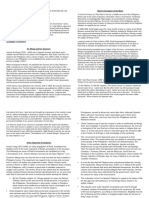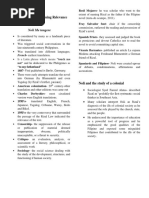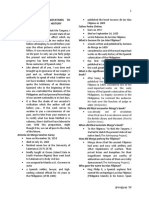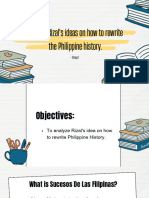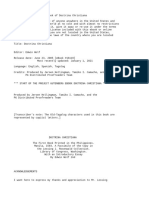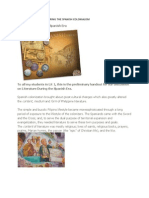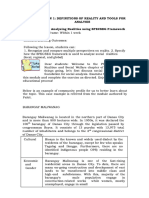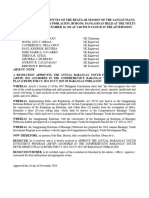0 ratings0% found this document useful (0 votes)
39 viewsFootnotes
Footnotes
Uploaded by
Bernard Emil Cortez1. This document discusses the history of writing and literacy among pre-Spanish and early Spanish period Tagalogs in the Philippines. It notes that while Tagalogs were literate, they did not have a developed literature, history, or record keeping like Western societies.
2. During the Spanish period, the Tagalog writing system involved carving letters into wood blocks to print texts. One of the first presses was established by the Dominicans in 1593. Several orders including the Augustinians and Jesuits later adopted printing to publish religious texts in Tagalog.
3. Over time, more secular texts were also printed for laypeople in addition to religious materials for priests. However, the early materials provide an
Copyright:
© All Rights Reserved
Available Formats
Download as DOCX, PDF, TXT or read online from Scribd
Footnotes
Footnotes
Uploaded by
Bernard Emil Cortez0 ratings0% found this document useful (0 votes)
39 views6 pages1. This document discusses the history of writing and literacy among pre-Spanish and early Spanish period Tagalogs in the Philippines. It notes that while Tagalogs were literate, they did not have a developed literature, history, or record keeping like Western societies.
2. During the Spanish period, the Tagalog writing system involved carving letters into wood blocks to print texts. One of the first presses was established by the Dominicans in 1593. Several orders including the Augustinians and Jesuits later adopted printing to publish religious texts in Tagalog.
3. Over time, more secular texts were also printed for laypeople in addition to religious materials for priests. However, the early materials provide an
Original Description:
footnotes for book analysis
Copyright
© © All Rights Reserved
Available Formats
DOCX, PDF, TXT or read online from Scribd
Share this document
Did you find this document useful?
Is this content inappropriate?
1. This document discusses the history of writing and literacy among pre-Spanish and early Spanish period Tagalogs in the Philippines. It notes that while Tagalogs were literate, they did not have a developed literature, history, or record keeping like Western societies.
2. During the Spanish period, the Tagalog writing system involved carving letters into wood blocks to print texts. One of the first presses was established by the Dominicans in 1593. Several orders including the Augustinians and Jesuits later adopted printing to publish religious texts in Tagalog.
3. Over time, more secular texts were also printed for laypeople in addition to religious materials for priests. However, the early materials provide an
Copyright:
© All Rights Reserved
Available Formats
Download as DOCX, PDF, TXT or read online from Scribd
Download as docx, pdf, or txt
0 ratings0% found this document useful (0 votes)
39 views6 pagesFootnotes
Footnotes
Uploaded by
Bernard Emil Cortez1. This document discusses the history of writing and literacy among pre-Spanish and early Spanish period Tagalogs in the Philippines. It notes that while Tagalogs were literate, they did not have a developed literature, history, or record keeping like Western societies.
2. During the Spanish period, the Tagalog writing system involved carving letters into wood blocks to print texts. One of the first presses was established by the Dominicans in 1593. Several orders including the Augustinians and Jesuits later adopted printing to publish religious texts in Tagalog.
3. Over time, more secular texts were also printed for laypeople in addition to religious materials for priests. However, the early materials provide an
Copyright:
© All Rights Reserved
Available Formats
Download as DOCX, PDF, TXT or read online from Scribd
Download as docx, pdf, or txt
You are on page 1of 6
NOTES: have no literature, no history, no
recordkeeping system, or any
1. Limpienza de Sangre: This policy
other activity which normally
required that a person should be
associate with a literate society
able to prove Old Christian
until the Spaniards came.
ancestry for four previous
5. “The matter of native writing
generations without Jewish or
during the pre-Spanish Era is
Muslim blood. Those who
problematic.” (Corpuz, 1989)
possessed such ancestry were
6. So accustomed are all these
regarded as having Limpienza de
islanders to writing and reading
Sangre. A person who failed to
there is scarcely a man, and much
fulfill the requirements was
less a woman, who cannot read
deemed to not possess purity of
and write in the letters proper to
blood.
the island of Manila, very different
2. Rule 3 stated that “the collegiate
from those of China, Japan, and
must be of pure race and have no
India. (Chirino, 1969, 280)
mixture of Moorish or Jewish
7. Throughout the islands the natives
blood, to the fourth degree, and
write very well, using certain
shall have no Negro or Bengal
characters… Almost all the
blood, or that of any similar nation,
natives, both men and women,
in their veins, or a fourth part of
write in this language. There are
Filipino blood.
very few who do not write it
3. Patronato Real was an
excellently and correctly. (Morga,
arrangement established by Pope
1609)
Julius II in which he granted Kind
8. The choice did not involve history,
Ferdinand and his successors that
law, literature, or other areas, as
exclusive right (1) to build
they were covered by oral
churches in the Spanish colonies;
tradition.
(2) to nominate candidates for
9. Refer to Chapter 3.
positions, including bishoprics,
10. Spanish friars not only used the
abbacies, canonries, and other
Chinese technology but also
ecclesiastical benefices, in
employed Chinese technicians
appointed or approved by the
who were familiar into this printing
Crown and depended on the
method.
Crown for his support. The Friars
11. It was a method used by Chinese
were, in other words, salaried
and familiar to the Tagalogs
government officials.
(known as limbag). The letters or
4. Although they were literate,
characters where hand-carved
Tagalogs never reached the exact
into pieces of wood blocks then, it
level of accomplishment of the
was inked and pressed against
Western expectation. What one
the paper.
finds among the Tagalogs, this
12. The Dominicans firstly owned a
population which can read and
printing press by 1593. According
write on a wide scale, is that they
to Retana, the Augustinians, printer was a non-native Tagalog
imported a printing press from speaker, a Christian-Chinese
Japan that was operated in named Juan de Vera who is also
Bacoor (1618), Lubao, Macabebe, responsible for the shift to the
and Manila (1621) then, it was typographic method of printing.
later sold to the Jesuits. 17. Tomas Pinpin printed Blancas de
13. One of the reasons they are the San Jose’s Artes y reglas de la
first order to dominate the Tagalog lengua tagala while Talaghay
Studies in the first fifty years of printed Pinpin’s Librong
Spanish presence in the pagaaralan. Unfortunately, little is
Philippines. known about Talaghay and
14. The Franciscans used to Pinpin’s work was the only listed
dominate of producing tagalog publication credited to him. Pinpin
works. However, all of those were on the other hand, went on to print
not published on the fact of at least fourteen works, and his
absence of printing press owned son, Simon, also printed fourteen.
or controlled by the Franciscans 18. Scott, William Henry. 1992.
and according to the Franciscan Looking for the Prehispanic
historical report, they were not Filipino. Quezon City: New Day
given to publish their works Publishers
because they are voluminous and 19. The use of “tribal” is minor
there are no arrangements. compared to the word “barangay”
According to Retana, they therefore it was the creation of a
published their own book in 1606. myth: the myth of the barangay.
The Augustinian press published 20. On September 21, 1974, Former
only three books from 1618 and President Ferdinand Marcos
1621. issued a Presidential Decree no.
15. He authored Libro de Nuestra 557 declaring all barrios in the
Senora del Rosario (1602), Libro Philippines as Barangays.
de los Sacramentos (1603), Libre 21. However, the author concludes
de Quatro Postrimerias (1604), that it is a construct which has no
Memorial de la vida christiana evidence to support it.
(1605), Tratado del Sacramento 22. Which was contradict by William
de la Confesion (c. 1607). His Henry Scott.
works were not for the priest but 23. The author concluded that
for the layman. He also wrote besides from Placensia’s study,
books written in Baybayin namely, those after him chose the wrong
Libro del Rosario de Nuestra name or title for the basic
Senora (1602), Libro Postrimerias organization of Tagalog society;
del Hombre (1605) etc. they chose the wrong concept and
16. However, the division of construct. Vicente Rafael comes
syllabication and phonic tantalizingly close to catching the
transcription, indicate that the heart of the issue: The confusion
of the data in early Spanish from those aspects that were
accounts stems from what seems Tagalog and those that were
like the inadequacy of Spanish Spanish. Number of scholars
political terminology, rooted in have examined the matter of
Roman Law and European counting among the Tagalogs of
feudalism, to comprehend the early Spanish period. Jean-
Tagalog social structure. There Paul Potet’s highly technical
appears to be a lack of fir between “Numerical Expressions in
Spanish descriptions and the Tagalog” and Ricardo Manapat’s
Tagalog reality they seek to paper “Matheatical Ideas in Early
convey. Perhaps, the difficulty Philippine Society”. Both of them
may be attributed to the were informative, but both papers
overdetermined nature of both suffer from a number of
Spanish political terminology and problems.
Tagalog designations of social 26. Tagalog borrowed the forms but
status. (Rafael, 1988,138) not necessary the thinking behind
24. “Correct or not, Spanish policies them. The core values remained
were based on this view of animism and its attendant
indigenous society. The datu, worldview., while the
translated as chief by Plasencia, surface/survival included a hybrid
was transformed later to Cabeza of Tagalog and Spanish forms.
de Barangay and society was This synthesis is what found in
reorganized accordingly. The Filipino society up until now.
barangay came to be accepted as 27. Written by local authorities and
the basic political unit of Tagalog signed by the same. The petitions,
society. However, the term dated 1665 (founded by Jean-
barangay, in describing political Paul Potet) and 1678 (founded by
structure quickly faded and was Luis C. Dery in the National
replaced by the Spanish barrio Archives of the Philippines), were
and part of the pueblo. Barangay addressed to the Archbishop in
continues to be heard as part of Manila and signed by more than
the new title for datus/cabeza de thirty men of Naujan, who
barangay.” represented its past and present
25. This is seen towards in various leadership.
aspects of tagalog culture. The 28. The Spaniards were surprised to
responses of the Tagalog find a near-universal literate
population towards borrowing and society. Baybayin was the system
adaptating varied all the way from of writing used for local
acceptance to indifference and languages, a fact supported by
rejection (Lhedan, 1959, viii-ix). Spanish accounts, a printing
However, often the borrowing ministry created in the face of that
was done to such an extent that reality, and surviving examples of
many have failed to differentiate
that writing. (cf. Woods 2011d, ch. Pangasinan, which was
2) intersected at different points by
29. As explained by Tomas Pinpin’s Zambales. Third, earlier reports
Librong pagaaralan nang manga regarding this “change” were more
Tagalog nang uican Castila, positive than the one quoted by
Spanish had both letters and Bernad. For, because of the
sounds not found in Tagalog as respect to his person, surely worth
written in Baybayin. Also, Spanish of the greatest promotion, we did
did not allow for interchangeable not dare to condemn his attempt
letters – u and o, e and i, d and r. as unjust; and more even, when
Thus, Pinpin’s work would help to he obtained it, making amends to
produce ladinos, bilingual Tagalog our reformed order for the wrong
who could speak and write in we received by a recompense
Spanish but also write in Tagalog which was fully justifiable in his
in romanticized letter. eyes. A chance offered him a
30. I assumed that, Tomas Pinpin’s suitable occasion for his project in
book played a major role in those the following manner. Don Diego
two petition manuscripts written by de Villatoro represented to the
local authories of Naujan and it Council of the Indias that the
somehow successfully reached island of Mindoro was filled with
the goal of his book, to become a innumerable heathens all sunk in
tool for survival and to produce a the darkness of their paganism
well-literate Tagalog who cannot and that if its conquest were
just only read and write Baybayin entrusted to any order, it would be
but can also read and write very easy to illuminate its
romanticized Tagalog words. inhabitants with the light of faith.
31. They took over Mindoro as Therefore a royal decree was
“compensation” for the mission in despatched, under date of Madrid,
Zambales, which the archbishop June 18, 1677, ordering the
had forced them to turn over to the governor of the islands, together
Dominicans. However, the with the archbishop, to entrust the
Recollects resigned themselves to reduction of Mindoro to the order
this disproportionate change, which appeared best fitted for it,
since the exertions to avoid it before all things settling the curas
availed nothing. (Bernad 1968,56) who resided the in prebends or
32. Three things should be noted chaplaincies. That decree was
here. First, the petitions were sent presented to the royal Audencias
to Archbishop Felipe Pardo whose of Manily by Sargento-mayor Don
being a Dominican might have Sebastian de Villareal, October
influenced his decision. Regarding 31, [16]78, and since his Majesty’s
Zambales being given to the fiscal had nothing to oppose, it
Dominicans. Second, the was obeyed without delay, and it
Dominicans had jurisdiction in was sent for fulfillment to the said
archbishop, December 14 of the de Herrera who describe himself
same year. On that account, his as a secretario de visita and later
Excellency formed the idea of adds notario publico in the
taking Zambales from us in order document. In spite of mixed
to augment his order and given orthography and the consistently
the island of Mindoro to our misspelled words, Herrera was a
discalced order. (Blair and Spaniard -- not a ladino. However,
Robertson 1903, 41:169-70) it is unlikely, Herrera did all if any
33. According to the accounts of of the physical writing.
Augustinian Recollects, the order 37. A name of Alonso Dias used to
who replaced the Jesuits. translate the testimony given in
34. The topic was founded in a the local language, was a form of
footnote of William Henry Scott’s Bisayan.
Prehispanic Source Materials for 38. The author did not state which
the Study of Philippine History. style of Bisayan was used by the
The original was believed to have witnesses to translate. (Bisayan:
been deposited on the request of Ilonggo, Bisayan: Aklanon, or the
a former American soldier who dialect of Bantayan, Cebu a
had stolen it during military looting mixture of Cebuano, Ilonggo,
in the early 20th century in Jaro, Waray-Waray and Masbetenyo
Iloilo as he took it as a souvenir. and Boholano).
When he is nearly dying, he asked 39. A soldier from Bantayn, Cebu with
a Catholic priest to return the a rank of Maestre de Ocampo, the
documents to their proper place. highest rank that can be obtained
That priest, in turn gave them to by an indio, who joined Spanish
the Maryknoll sisters. However, forces to fought in Mindanao.
the original copy had been (probably, muslims).
damaged and ultimately thrown 40. A principalia.
out. Until, a name of Pennie 41. Both were from Bantayan and
Azarcon-dela Cruz asked the married there.
author that a photocopy of the 42. It challenges the preconceptions
script has been obtained by many hold about women during
Filipinas Heritage Library. the Spanish colonial period in the
35. Some vital information of the Philippines, divorce, and the
document was not included due to Catholic Church, as the extent of
various circumstances and there hispanization, the work of the
were missing pages that are friars in the islands, and much
presumably lost. more. According to the traditional
36. The presiding authority was Don view, this case simply should not
Gregorio Ruiz Descalona, a be possible. And many who take
Spaniard affiliated with the that view would state
cathedral in Manila. The scribe of unequivocally that no such case
the document was Juan Moreno
could ever have been brought, let
alone won.
43. Record and reports from early
Spanish sources indicate that
divorce was, in fact, a part of life in
the precolonial Bisayas and it is
not unusual because of egalitarian
views of Visayans concerning
sexe and autonomous behavior
and customs by them which were
implicit contrast with the Tagalogs.
You might also like
- Model Minutes of The Session of The Sangguniang BarangayDocument5 pagesModel Minutes of The Session of The Sangguniang Barangayfcgomezjr94% (140)
- Template Annex A BOIS Form Revised 2023Document1 pageTemplate Annex A BOIS Form Revised 2023nikkogaston100% (10)
- Frank Salomon. Huarochiri ManuscriptDocument46 pagesFrank Salomon. Huarochiri Manuscriptluis muma100% (3)
- Chapter 5 Rizal's Search For OriginDocument11 pagesChapter 5 Rizal's Search For OriginNatepretty100% (3)
- Doctrina Christiana The first book printed in the Philippines, Manila, 1593.From EverandDoctrina Christiana The first book printed in the Philippines, Manila, 1593.No ratings yet
- WEEK 3 RIPH Juan de Plasencias Customs of The TagalogsDocument10 pagesWEEK 3 RIPH Juan de Plasencias Customs of The TagalogsBeverly A Panganiban100% (1)
- Rizal Finals ReviewerDocument28 pagesRizal Finals Reviewerlopezgetrudes9No ratings yet
- Rizal and Morga111Document45 pagesRizal and Morga111Edison Salgado CastigadorNo ratings yet
- Doctrinal CristianaDocument11 pagesDoctrinal CristianaByron WebbNo ratings yet
- 1 Customs of The TagalogDocument3 pages1 Customs of The TagalogMille KaiaNo ratings yet
- Content and Contextual Analysis Customs of The Tagalogs (Briana Franco COIR 1-BDocument5 pagesContent and Contextual Analysis Customs of The Tagalogs (Briana Franco COIR 1-BBree FrancoNo ratings yet
- Chapter 11 12Document3 pagesChapter 11 12Mary AlberneNo ratings yet
- Rizal and MorgaDocument26 pagesRizal and MorgaEdison Salgado Castigador100% (1)
- Ebook of Doctrina ChristianaDocument203 pagesEbook of Doctrina ChristianangamoloNo ratings yet
- Vol17 1GonzalezTristanDocument9 pagesVol17 1GonzalezTristanLalo GonzálesNo ratings yet
- History of Philippine LiteratureDocument8 pagesHistory of Philippine LiteratureprincessbsalonNo ratings yet
- Module 2 Lesson 1 Customs of The Tagalogs - PPTSXDocument24 pagesModule 2 Lesson 1 Customs of The Tagalogs - PPTSXcaratarmyblinkNo ratings yet
- Lesson PlanDocument7 pagesLesson PlanBeberly Kim AmaroNo ratings yet
- 2016-2017 Early Period Ancient Filipino ScriptDocument222 pages2016-2017 Early Period Ancient Filipino ScriptAngelicaNo ratings yet
- Dr. Jose Rizal'S Annotations To Morga'S 1609 Philippine HistoryDocument5 pagesDr. Jose Rizal'S Annotations To Morga'S 1609 Philippine HistoryYo Mama100% (2)
- Additional Information JP RIZALDocument2 pagesAdditional Information JP RIZALkim minjiNo ratings yet
- 1 Chuchiak Writing As Resistance 87Document30 pages1 Chuchiak Writing As Resistance 87fugicotorraNo ratings yet
- RPH Midterm Reviewer9Document10 pagesRPH Midterm Reviewer9Sin AvalloneNo ratings yet
- 5.1 Looking at The Filipino Past - 3: Audencia EcclesisticsDocument7 pages5.1 Looking at The Filipino Past - 3: Audencia EcclesisticsAbegail LaronNo ratings yet
- Doctrina ChristianaDocument69 pagesDoctrina ChristianaOwen Silva NaldozaNo ratings yet
- LWR Group 1 PPT FinalsDocument39 pagesLWR Group 1 PPT FinalsFMangonon, Jarrah Mae B.No ratings yet
- Liworiz 3rd ShiftingDocument10 pagesLiworiz 3rd ShiftingKATHLEEN CALALANGNo ratings yet
- Readings in Philippine HistoryDocument9 pagesReadings in Philippine HistoryEddie Agbayani Jr.No ratings yet
- HndoutDocument6 pagesHndoutRandolf MartinezNo ratings yet
- Customs of The TagalogsDocument6 pagesCustoms of The TagalogsAmer ArtesanoNo ratings yet
- Doctrina ChristianaDocument135 pagesDoctrina ChristianaBooks100% (4)
- MODULE 2 Juan PlacenciaDocument12 pagesMODULE 2 Juan PlacenciaKiara Adelene GestoleNo ratings yet
- Module 5.2 Customs of The Tagalogs 3Document67 pagesModule 5.2 Customs of The Tagalogs 3malisebossNo ratings yet
- Chapter 2 Understanding The Significance of Primary SourcesDocument34 pagesChapter 2 Understanding The Significance of Primary SourcesCASIMERO, KENJI B.No ratings yet
- Kawahara, Toshiaki - A Study of Literacy in Pre-Hispanic PhilippinesDocument14 pagesKawahara, Toshiaki - A Study of Literacy in Pre-Hispanic PhilippinesBrian LeeNo ratings yet
- Rizals-Reporting-Group-1 20231201 163541 0000.pdf 20231201 165930 0000Document24 pagesRizals-Reporting-Group-1 20231201 163541 0000.pdf 20231201 165930 0000chaibalinNo ratings yet
- RegDocument11 pagesRegRenee Rose AmacanNo ratings yet
- RizalDocument3 pagesRizalbeanieNo ratings yet
- Rizals Annotation and PoemDocument5 pagesRizals Annotation and PoemFrancisNo ratings yet
- Module-5 Rizal 1Document12 pagesModule-5 Rizal 1Lester AmadoNo ratings yet
- History of Literature and Philippine EventsDocument10 pagesHistory of Literature and Philippine EventsDanica NaldoNo ratings yet
- RPH Midterm ReviewerDocument7 pagesRPH Midterm ReviewerElynne RespicioNo ratings yet
- Doctrina Christiana by Edwin WolfDocument69 pagesDoctrina Christiana by Edwin Wolfaurora7500No ratings yet
- The Philippine LiteratureDocument35 pagesThe Philippine LiteratureRoanne Lagua100% (1)
- The Manila Synod of 1582: Cases and Abuses in The Philippine IslandsDocument6 pagesThe Manila Synod of 1582: Cases and Abuses in The Philippine IslandsRachelle Zaragosa SolimanNo ratings yet
- Lit ReviewerDocument9 pagesLit ReviewerA Cat And a DogNo ratings yet
- Handout in Rizal G 2Document9 pagesHandout in Rizal G 2batojenniferestreraNo ratings yet
- RIZAL-Final Exam CoverageDocument4 pagesRIZAL-Final Exam CoverageMean MirafuentesNo ratings yet
- Rizals AnnotationsDocument5 pagesRizals AnnotationsJomeljames Campaner PanganibanNo ratings yet
- Mojares BARLAANURBANABASIO 1976Document10 pagesMojares BARLAANURBANABASIO 1976Alden PilongoNo ratings yet
- Life and Works of Rizal ReviewerDocument26 pagesLife and Works of Rizal ReviewerTrisha GolesNo ratings yet
- Spanish ColonialDocument3 pagesSpanish ColonialQuenie SalomaNo ratings yet
- Bartoleme de Las Casas_The Eternal Gaurdian of the IndiansDocument12 pagesBartoleme de Las Casas_The Eternal Gaurdian of the Indiansantonioc2202No ratings yet
- Juan de PlasenciaDocument1 pageJuan de PlasenciaShaReyNo ratings yet
- 21st 001Document7 pages21st 001Regine Gale UlnaganNo ratings yet
- Literature of The Ancient FilipinosDocument1 pageLiterature of The Ancient FilipinosmloscosNo ratings yet
- Annotations of Antonio Morgas Sucesos de Las IslasDocument18 pagesAnnotations of Antonio Morgas Sucesos de Las Islascymfeli100% (5)
- BSN 2 Philippine HistoryyDocument27 pagesBSN 2 Philippine HistoryyMA. YSABEL REYESNo ratings yet
- Customs of The TagalogsDocument4 pagesCustoms of The Tagalogsellamaecenriquez80% (45)
- Friars and Filipinos An Abridged Translation of Dr. Jose Rizal's Tagalog Novel, 'Noli Me Tangere.'From EverandFriars and Filipinos An Abridged Translation of Dr. Jose Rizal's Tagalog Novel, 'Noli Me Tangere.'No ratings yet
- Barangay Sta Rita Office of The Sangguniang Kabataan ChairpersonDocument2 pagesBarangay Sta Rita Office of The Sangguniang Kabataan ChairpersonArlene Diño Amurao100% (2)
- BDC 2022 - SupplementalDocument5 pagesBDC 2022 - SupplementalJhon Paul AlejoNo ratings yet
- Barangay LettersDocument3 pagesBarangay LettersLevi GomezNo ratings yet
- 206 Case StudyDocument9 pages206 Case StudyJimmy RustleNo ratings yet
- Aggravating CircumstanceDocument25 pagesAggravating CircumstanceRose Anne CaringalNo ratings yet
- Condemnation FilesDocument5 pagesCondemnation FilesApril Joy Sumagit HidalgoNo ratings yet
- Barangay AssemblyDocument2 pagesBarangay AssemblyMark Brendon Jess Vargas100% (24)
- Eo 016 Beswmc-2023Document2 pagesEo 016 Beswmc-2023manilyn cailyoNo ratings yet
- Abyip 2024Document12 pagesAbyip 2024Sunshowie Panganting100% (1)
- Comprehensive Barangay Youth Development PlanDocument25 pagesComprehensive Barangay Youth Development PlanEmmanuel Mascuñana BacayNo ratings yet
- HBSE1Document6 pagesHBSE1Frences Erica Decinal PuyogaoNo ratings yet
- R003-2023 Sangguniang Kabataan IRP (Revised)Document9 pagesR003-2023 Sangguniang Kabataan IRP (Revised)Vianica Kaye Israel100% (1)
- 20 Resolution (Augmentation of Fund) 2019Document2 pages20 Resolution (Augmentation of Fund) 2019anabel100% (2)
- 3.3 SK MC - ANNEX A CBYDP SK Full Public Disclosure - Template 1Document10 pages3.3 SK MC - ANNEX A CBYDP SK Full Public Disclosure - Template 1Johncel Palomata BuezaNo ratings yet
- Resolution On Approving Pops Plan - 2020-2022Document2 pagesResolution On Approving Pops Plan - 2020-2022BARANGAY MOLINO II100% (9)
- Resolution No. 05 - Anti-Noise OrdinanceDocument3 pagesResolution No. 05 - Anti-Noise OrdinanceEileen Arceo100% (1)
- Local Media733327375199792446Document4 pagesLocal Media733327375199792446Joshua James PaduaNo ratings yet
- Bois Form UpdatedDocument2 pagesBois Form Updatedjuliusgob18No ratings yet
- MahayagDocument2 pagesMahayagRio AlbaricoNo ratings yet
- Resolution For Load AllowancwDocument11 pagesResolution For Load AllowancwBrgy Duran Nabua Cam SurNo ratings yet
- Memo On Turnover - SK PDFDocument2 pagesMemo On Turnover - SK PDFFatima Mercado Alon50% (2)
- Barangay Poblacion: Republic of The Philippines Province of Agusan Del Sur Municipality of SibagatDocument2 pagesBarangay Poblacion: Republic of The Philippines Province of Agusan Del Sur Municipality of Sibagatnorie garcesNo ratings yet
- Resolution Road ExpansionDocument1 pageResolution Road ExpansionLeei Ahrr100% (1)
- Reso Brgy SapangDocument2 pagesReso Brgy SapangBryan BautistaNo ratings yet
- Abyip ResolutionDocument1 pageAbyip ResolutionRonson NgayawanNo ratings yet
- Reso AWFP 2023 01Document6 pagesReso AWFP 2023 01Barangay Mate TayabasNo ratings yet
- Barugo DRRM PlanDocument50 pagesBarugo DRRM PlanPolcomar Ponferrada CanonceNo ratings yet
- Badac AppointmentDocument34 pagesBadac AppointmentjeffthephilipNo ratings yet






